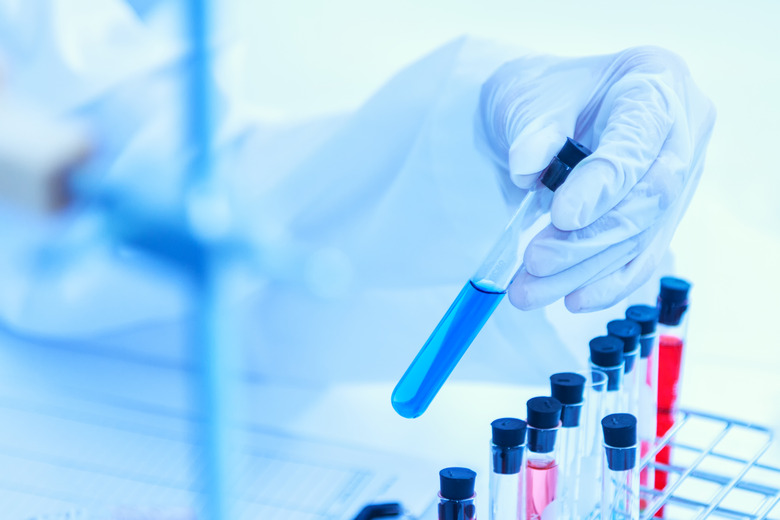How To Calculate Theoretical Percent
Each chemical compound contains a combination of atoms, and one way to understand theoretical percent is to equate it to the percentage of a particular element in a compound. This percentage isn't based on numbers of atoms, but on the total mass of the element relative to the mass of the compound.
Another way to understand theoretical percent is in the context of a chemical reaction. In any reaction, the total molar mass of each element involved in the reaction must be conserved. You can calculate the mass of each product as long as you know the chemical formulas of all the reactants and products. This is the theoretical yield for that product. The actual yield is almost always less for a number of reasons. The ratio of actual to theoretical yield gives you a quantity called percent yield.
TL;DR (Too Long; Didn't Read)
To calculate the theoretical percentage of an element in a compound, divide the molar mass of the element by the mass of the compound and multiply by 100. In a chemical reaction, the percent yield of a product is its actual yield divided by its theoretical yield and multiplied by 100.
Calculating Theoretical Percent of an Element
Calculating Theoretical Percent of an Element
To calculate the theoretical percent of each element in a compound, you have to know the chemical formula of the compound. Knowing this, you can calculate the mass of the compound by looking up the atomic masses of each of the elements and adding them together. If an element has a subscript following its symbol, multiply the mass of that element by the subscript before doing the summation. Once you know the mass of the compound, you calculate the theoretical percent of each element by dividing the atomic mass of that element – multiplied by the subscript that follows it in the formula – by the mass of the compound and multiplying by 100.
Example: What is the theoretical percent of carbon in methane (CH4)?
1. Look up the Atomic Masses of the Elements
Find the masses in the periodic table. The atomic mass of one mole of carbon (C) is 12.01 g, and that of hydrogen (H) is 1.01 g, rounding to two places.
2. Calculate the Mass of One Mole of the Compound
Sum the masses of carbon and hydrogen. Remember to multiply the mass of hydrogen by 4 because there are four hydrogen atoms in the molecule, indicated by the subscript. This gives a mass of 16.05 g for the methane molecule.
3. Calculate the Theoretical Percent of Carbon
Divide the mass of carbon by the mass of methane and multiply by 100.
(12.01 ÷ 16.05) × 100 = 74.83%
Note that, even though methane contains four hydrogen atoms and only one carbon atom, carbon makes up three-quarters of the compound.
Calculating Percent Yield in a Reaction
Calculating Percent Yield in a Reaction
You calculate the theoretical yield of a particular product in a reaction from the balanced equation for the reaction, and you determine the actual yield by experiment. There's no way to predict actual yield – you have to measure it. The percent yield is the actual yield divided by the theoretical yield multiplied by 100.
Example: Calcium carbonate (CaCO3) dissolves in water to produce calcium bicarbonate (CaO) and carbon dioxide (CO2). If 16 g of CaCO3 yields 7.54 g CaO, what is the percent yield of CaO?
1. Write the Balanced Equation
The balanced equation for the reaction is: CaCO3 –> CaO + CO2.
2. Calculate the Number of Moles of Reactant
Divide the measured mass of calcium carbonate (16 g) by the molar mass of the compound (100 g) to get 16 ÷ 100 = 0.16 moles.
3. Calculate the Theoretical Yield of CaO
According to the equation, one mole of CaCO3 produces one mole of CaO, so 0.16 moles of CaCO3 produces 0.16 moles of CaO. The molar mass of CaO is 56 g, so 0.16 moles of the compound = 56 g × 0.16 = 8.96 g.
4. Calculate the Percent Yield
In this experiment, only 7.54 g of CaO were recovered, so the percent yield is:
(7.54 ÷ 8.96) × 100 = 84.15%
Cite This Article
MLA
Deziel, Chris. "How To Calculate Theoretical Percent" sciencing.com, https://www.sciencing.com/calculate-theoretical-percent-2826/. 6 June 2018.
APA
Deziel, Chris. (2018, June 6). How To Calculate Theoretical Percent. sciencing.com. Retrieved from https://www.sciencing.com/calculate-theoretical-percent-2826/
Chicago
Deziel, Chris. How To Calculate Theoretical Percent last modified August 30, 2022. https://www.sciencing.com/calculate-theoretical-percent-2826/
